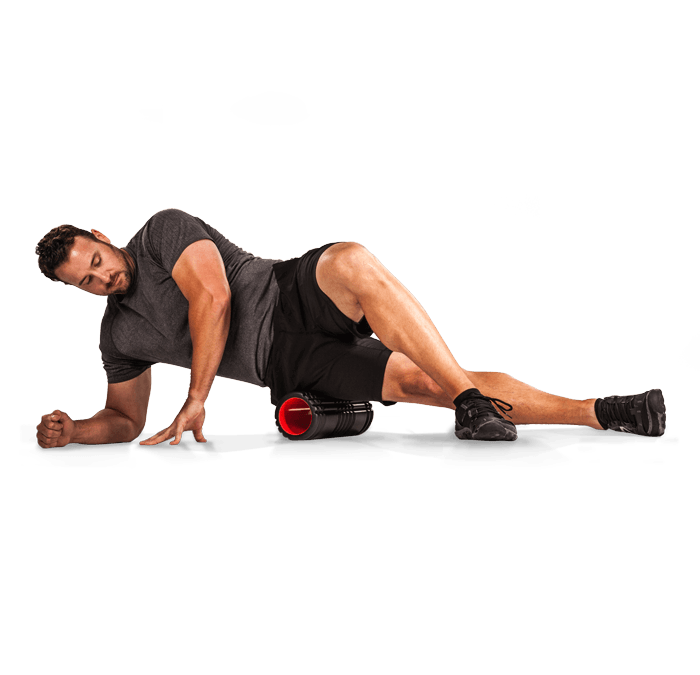When stress, anxiety and fatigue combine, the body reacts by tightly contracting the muscles. Eventually, bands or knots form in muscle tissue that will not release on their own. These painfully tight spots are called trigger points. Trigger points can refer pain to other parts of the body and contribute to fatigue and insomnia. If not released, trigger points will worsen over time and can lead to functional problems.
When people develop stress related trigger points they often believe the only solution is a professional massage. Truthfully, there is no need to spend hundreds of dollars on professional massage to feel better. Studies have shown that a consistent self-massage routine with a foam roller can provide immediate relief and lasting results from stress related trigger points. With the right tools and just 15 minutes per day, you can relieve stress related trigger points, decompress your muscles and sleep better every night.
Foam rollers come in a variety of sizes and materials. Soft foam rollers contour to the body to work the tension out of the superficial muscles. Firm rollers, such as hollow core rollers, work deeper into the muscle tissue. Long rollers are ideal for working the full length of the spine, while shorter rollers are easy to manoeuvre for mobility exercises. If you are foam rolling for stress relief and relaxation start with a long, soft roller. The best rollers are textured to mimic the feeling of a massage therapist’s hands.
To work out tight spots at the end of a long day and sleep more soundly throughout the night try these simple muscle release techniques:
Spine Roll Release
To perform a spine roll release:
1. Lay with the roller placed lengthwise along your spine with the pelvis and head comfortably positioned on top of the roller.
2. Lay your arms to the sides, using the ground for stabilisation.
3. Gently rock from side to side to allow the roller to massage the muscles and ligaments on either side of your spine.
Benefits of the Spine Release: Rolling the spine can help to re-hydrate and mobilise the spinal erectors and other muscles near the spine. It also provides a small amount of decompression throughout the length of the spine.
Mid/Upper Back Release
To perform mid/upper back release:
1. Lay on the floor with the roller positioned just below your shoulder blades.
2. Place your hands behind your head to support your neck muscles.
3. Gently roll forward and back, then stop every few inches and move side to side to target all the muscles in the upper back.
Benefits of the upper back release: The muscles in the shoulders and upper back are very commonly associated with trigger points from stress and anxiety. The upper back roll gently applies pressure to the muscles and assists in releasing trigger points.
Neck Release
To perform neck release:
1. Lay with the roller under your neck like a pillow.
2. Slowly turn your head from side to side in a “no” motion to gently massage and release tension.
3. Do not press your neck down into the roller. The weight of your head to provides just enough pressure on these small muscles.
Benefits of the neck release: At the base of the skull is a small group of muscles that serves to control and stabilise the head. They contain many sensory receptors, therefore providing a significant amount of feedback to the nervous system about the position the head and neck is in. These muscles can become overworked and chronically shortened. As these muscles adapt to the shortened position they can begin to impede blood flow to the brain and can be associated with tension headaches and chronic neck pain. Releasing these muscles can provide relief from chronic pain and headaches.
In addition to these foam rolling release techniques, try incorporating a foam roller into your regular yoga routine for an added stretch and muscle release. Try these assisted yoga poses with your foam roller:
Assisted Child’s Pose
Kneel on the ground with your arms outstretched in front of you.
1. Position the foam roller in front of you under your wrists in a hands and knees position.
2. Slowly roll the arms forward while pushing the glutes back toward the heels into child’s pose.
3. Roll back to the starting position and repeat.
Assisted Pigeon Stretch
1. Sit on the floor with one leg bent in front of the body and the opposite leg extended backwards with toes pointed.
2. Place the foam roller in front of the hips with your palms on the roller.
3. Slowly roll forward and bring your chest toward the floor.
4. Reverse the motion and repeat.
In addition to relaxation, foam rollers can also be used for flexibility, mobility training and pre or post workout stretching. Remember to start slowly and work your way into each exercise gently. Good Luck and Happy Rolling!

